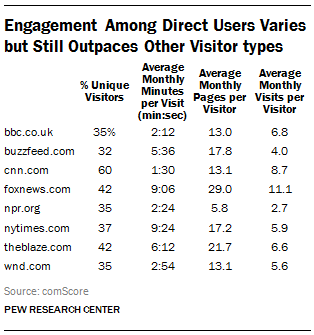
Pew study assesses loyalty of digital news consumers
Photo credit: Flickr user Amr Tahtawi.
Engagement with content on news websites is much higher among direct visitors–users who type in the URL or arrive via a bookmark in their browser–than visitors who arrive through search engines and Facebook referrals.
That’s one of the conclusions of a Pew Research Center report released today titled “Social, Search & Direct: Pathways to Digital News.” The report analyzes traffic sources among 26 popular news sites and how the manner in which visitors arrive on the site influences the duration of their visit and the frequency of their visits per month. The report is the latest installment in a research partnership between Pew and Knight Foundation studying news consumption on social media, and builds upon a recent report profiling Facebook news consumption.
The primary finding about the highest engagement occurring among direct visitors is an obvious statement on visitor loyalty, but it sets the stage for future research. The important question is how to convert these casual news browsers into loyal news consumers, which is especially key for news sites with revenue models dependent upon digital subscriptions.
Here are a few other insights from the report:
Differences in visitor source composition by site
The share of traffic arriving via Facebook and search engines varies dramatically across sites; for example, referrals from Facebook constitute 50 percent of Buzzfeed traffic compared to 3 percent of Yahoo News traffic. This provides insights about which sites are effectively using social media and search engine optimization, but it needs to be weighed against total traffic to sites and whether users coming via search and social media over time begin to directly access news sites.
Consistent visit duration across sites for search and Facebook referral traffic

But when it comes to the level of engagement, users on all news sites that arrive via search engines or Facebook engage at lower levels than direct visitors to the site. Average time on site was nearly identical for Facebook (1:41) and search (1:42), about one-third the average visit duration for direct visitors (4:36). The small range for average Facebook visit duration across sites (the shortest was 1:12; the longest was 3:12) speaks to the similarity in the way these users engage independent of news site (see Figure 1).
Engagement by direct visitors varies widely by site

Though average visits per month for people arriving via Facebook or search was consistently between once or twice for all news sites, average visits among direct visitors ranged quite a bit across sites from foxnews.com (11.1) on the high end to forbes.com (1.5) on the low end. Time on site also varied dramatically when it came to direct visitors, with long duration on some sites including nytimes.com (9:24) and much shorter durations on other sites such as cnn.com (1:30) (see Figure 2).
This latest round of data advances the understanding of how people consume news. This research is critical as news organizations confront challenges of developing new audiences and sustaining current ones in the competitive landscape of modern media. Still, it’s just one step in understanding how information flows. There’s more to come in the year ahead, which will help expand our understanding even more.
Jonathan Sotsky, director of strategy and assessment at Knight Foundation
Recent Content
-
Journalismarticle ·
-
Journalismarticle ·
-
Journalismarticle ·


